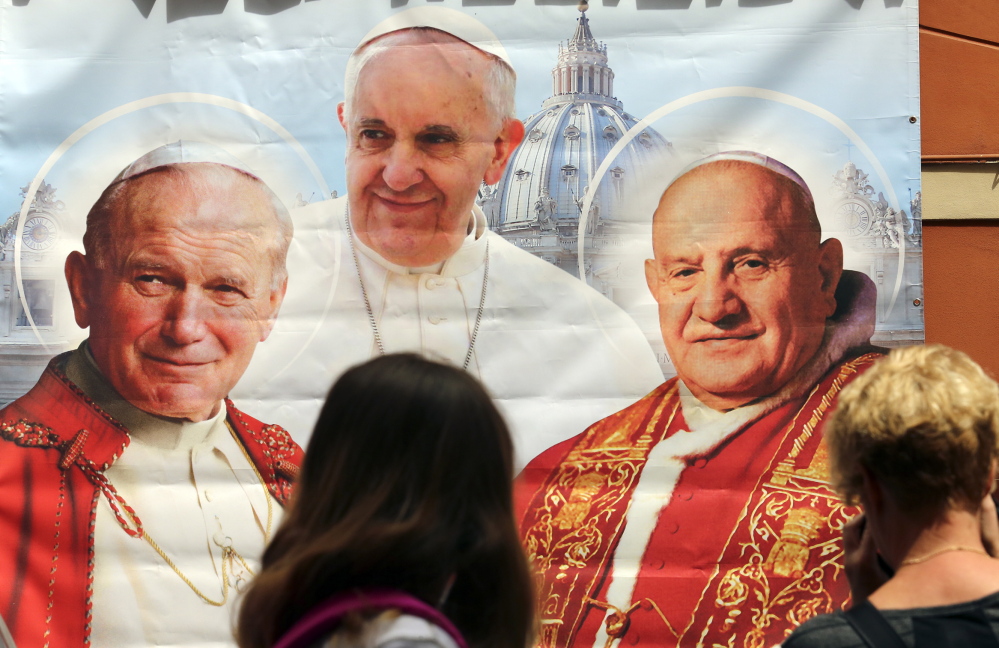VATICAN CITY — Catholic saints are said to be the stuff of miracles, celestial servants who bend God’s ear to aid the desperately ill. But Pope Francis may be sending a new message to the globe’s 1 billion Catholics.
In the 21st century, maybe saints can be a little less miraculous.
On Sunday, hordes of pilgrims will mass in St. Peter’s Square and in front of big screens erected across Rome for the canonizations of John Paul II and John XXIII. The crowds, along with a global audience, will watch as two popes are jointly proclaimed saints for the first time in the 2,000-year history of the church. But is the bar being lowered for sainthood?
The path to sainthood for John Paul II was the fastest in modern history, raising eyebrows among traditionalists for packing a painstaking process that can sometimes take centuries into nine incredibly short years.
In the case of John XXIII, Francis took what sticklers decry as an even more radical step. He dispensed with the Vatican’s modern requirement for two vetted and verified miracles to become a saint, effectively accepting a single 1966 case of a nun allegedly cured of gastrointestinal hemorrhaging after praying to John XXIII as enough.
Such moves by popes are not unprecedented and John Paul II was particularly known as a saint-making machine willing to bend the rules. But in only 13 months, Francis has already exercised his right to “equipollent canonization” – a papal prerogative to fast-track saints by requiring fewer proven miracles – more times than any other pontiff since Leo XIII, who served from 1878 to 1903. In three cases, Francis elevated saints without a single confirmed miracle under their virtuous belts.
Francis has yet to spell out his rationale, and in the benevolent dictatorship that is Vatican City, it is not in the nature of clerics to demand explanations from a reigning pope. But for better or worse, Francis’s tendency to bypass the normal channels for certifying miracles is generating friction inside the ancient Vatican walls even as it reignites an age-old debate over the nature of Catholic saints.
Some hope the reforming new pope is moving to modernize the image of saints. The time has come, they say, to shift the emphasis from the mystical nature of saints toward their status as role models. Still others are pressing for a new definition of miracles in the Internet age, embracing not just vanished tumors and healed aneurysms, but also drug addicts who quit and divorced couples reunited after praying to prospective saints.
“I know the holy father well enough to know that he believes in miracles, as we all do, but the question is simply and purely, should we require the confirmation of miracles for saints?” asked the Rev. Peter Gumpel, a senior Vatican figure and church historian.
One camp in the church is all in favor of lowering the bar. Such a move could open the door to more and faster-made saints, who tend to serve as public relations dynamos for the faith in their countries of origin – a fact seen as a huge bonus as the Vatican casts its eye on fast growth in Africa and Asia. It could also pave the way to the quicker elevation of potential blockbuster saints such as Mother Teresa, whose first miracle, recognized by the Vatican in 2002, has been challenged by doctors and who is still waiting for confirmation of a second.
The proclamation of saints “helps strengthen the faith of the people,” said the Rev. Slawomir Oder, the Polish monsignor who presented John Paul II’s case for sainthood to Vatican judges.
Yet just as in other areas where the new pope is upending conventions, Francis’ actions are touching a raw nerve with traditionalists who see danger ahead should he continue the trend.
The belief that Catholics can directly pray to saints to intercede with God on their behalf remains a fundamental division between them and many Protestants. If more saints are created without vetted miracles, critics argue the glow of the faith could fade for millions – especially in parts of Latin America where the cult of adoration to the statues of saints remains strong.
“Francis has caused some apprehension among the Vatican saint-makers, who see the pope waving his hand and saying we don’t need to follow these rules as much,” said John Thavis, author of “The Vatican Diaries.” “They are saying, ‘We need to be very careful about how we do this.’ ”
The dozens of Vatican lawyers, medical experts and theologians involved in the minting of saints consider the process both art and science. In the old days, claims of incorruptible bodies and sweet fragrances emitting from graves were considered some of the telltale signs of saints. But these days, the church largely relies on medical cures, seen as miracles only when they are instantaneous, lasting and clearly attributable to divine intervention.
Send questions/comments to the editors.



Success. Please wait for the page to reload. If the page does not reload within 5 seconds, please refresh the page.
Enter your email and password to access comments.
Hi, to comment on stories you must . This profile is in addition to your subscription and website login.
Already have a commenting profile? .
Invalid username/password.
Please check your email to confirm and complete your registration.
Only subscribers are eligible to post comments. Please subscribe or login first for digital access. Here’s why.
Use the form below to reset your password. When you've submitted your account email, we will send an email with a reset code.